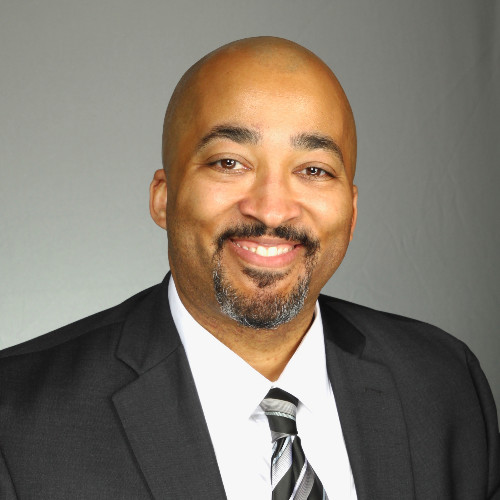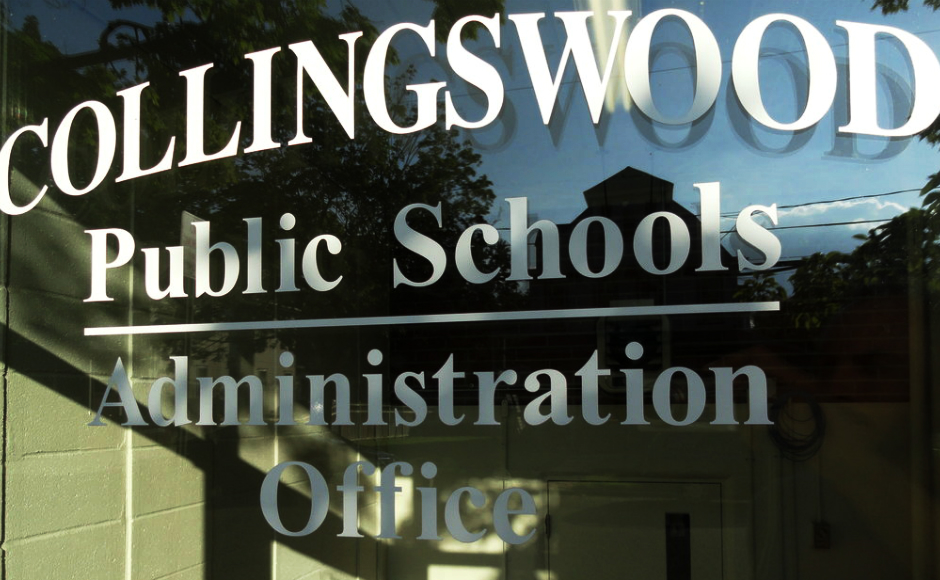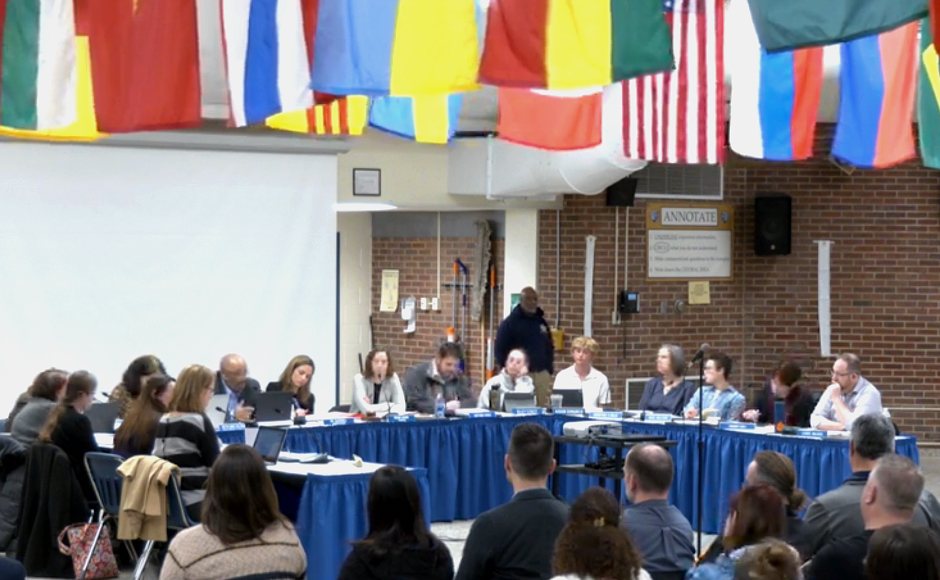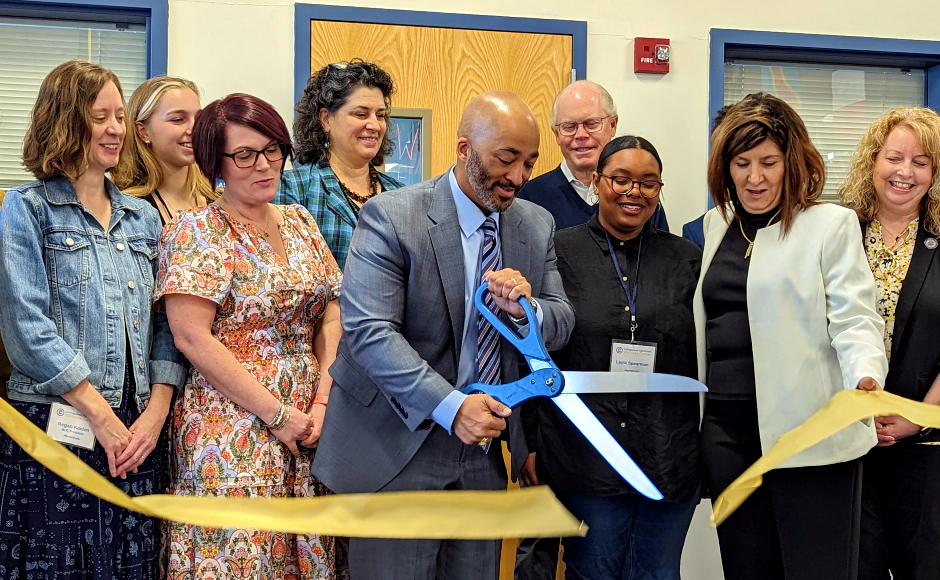Recently renewed Collingswood Superintendent of Schools Fredrick McDowell is tasked with leading the district through labor negotiations and a bond referendum, even as the broader community continues to experience racial and economic change.
By Matt Skoufalos | February 21, 2024
In late January, the Collingswood and Oaklyn Boards of Education (BOE) voted to renew the contract of Superintendent of Schools Fredrick McDowell for another three years.
McDowell serves as the superintendent of both the Oaklyn and Collingswood school districts, and representatives from each had a hand in his selection.
Ahead of the vote at the January 22 Collingswood BOE meeting, public comment was a raucous affair, with district teachers taking to the microphone to voice their frustrations with conditions at Collingswood High School (CHS).
Many laid their concerns directly at the feet of the superintendent.
“The lack of stable student-teacher relationships is negatively impacting student education and success,” CHS math teacher Lisa Hall said.
“We have a talent attraction problem,” Hall said. “We have retention issues as we continue to lose talented, tenured teachers.”
“We certainly are being asked to do a lot more with less,” said CHS special education social studies teacher Jeff Herrman, who circulated a list of staff members who have departed the district since the start of the 2022 school year.
Veteran CHS phys ed teacher Nancy O’Neill, a borough lifer who’s taught in the district for 30-plus years, said the school environment has soured her so much that she wouldn’t want her own children to apply for jobs in Collingswood.
“The biggest issue in this school district right now, and the reason why people are leaving, is because of the lack of support and the feeling that we are [not] appreciated,” O’Neill said.
“This is not Collingswood,” she said. “We have to have people who support us and communicate with us.”
Turnover rates
Staff departures from the district certainly have elevated in recent years.
According to figures provided by the district, Collingswood Public Schools turned over an average of 19 employees per year from 2017 to 2020.
That count runs across all job categories, with a single-year low of 15 and a high of 28 people leaving the district in that period.
From 2021 to 2023, however, that average has doubled, to 38 staffers per year, with a single-year low of 22 and a high of 50. Since the beginning of the 2023-2024 school year, Collingswood has shed 14 staff members.
These figures account for total staff departures of all kinds (teachers, administrators, secretaries, custodians, maintenance crews, etc.), and for all reasons (retirements, resignations, non-renewals, contract expirations, permanent jobs elsewhere, other personal reasons), even death.
Collingswood also employs some 75 to 100 instructional assistants whose employment is managed by ESS Education, a staffing agency that specializes in school district human resources. These employees were excluded from the district calculus.
McDowell sees the novel coronavirus (COVID-19) pandemic as a clear dividing line in those metrics: in the years since students returned to in-person instruction, the average staff attrition rate in the district has nearly doubled. In response, the district began offering staff exit interviews last year; their results are as distinct as the individuals polled, the superintendent said.
“I share them with the Board of Education, so the Board of Education is acutely aware of the reasons why the individuals are making the decision to retire, resign, or, in some cases, leave the teaching profession altogether,” the superintendent said.
“Between Collingswood and Oaklyn, we have 500 employees,” he said. “If five percent of folks decide this is not the organization they wish to belong to, and they want to go somewhere else, you could have 20 different reasons for why that is true.”
Statewide, the attrition rate in New Jersey school districts ranges from 3 to 38 percent, McDowell said.
Even at its highest turnover rate post-COVID, that would still place Collingswood at the lower end of the scale, at less than 8 percent.
The challenge comes in sourcing replacements for those who leave.
“That’s nothing to be proud of, but that’s the reality,” McDowell said. “We’ve had several individuals early in their career decide that teaching is not their profession. There’s been a significant decrease of individuals even graduating with a teaching degree and entering the field since 2009.”
The superintendent described the “overwhelming majority” of turnover within the Collingswood school district as happening at the CHS campus, which was well-represented at the January 22 meeting. He also spoke about the district perspective as being rooted in addressing those complaints that it is capable of handling. Pay increases aren’t necessarily on that list.
“Districts with deeper pockets are able to add bonuses or higher pay scales; if that’s your sticking point, that’s something we cannot influence,” McDowell said. “The things that we can influence are the things we’re trying to influence. If there’s an action we can take, we’ll take it.”
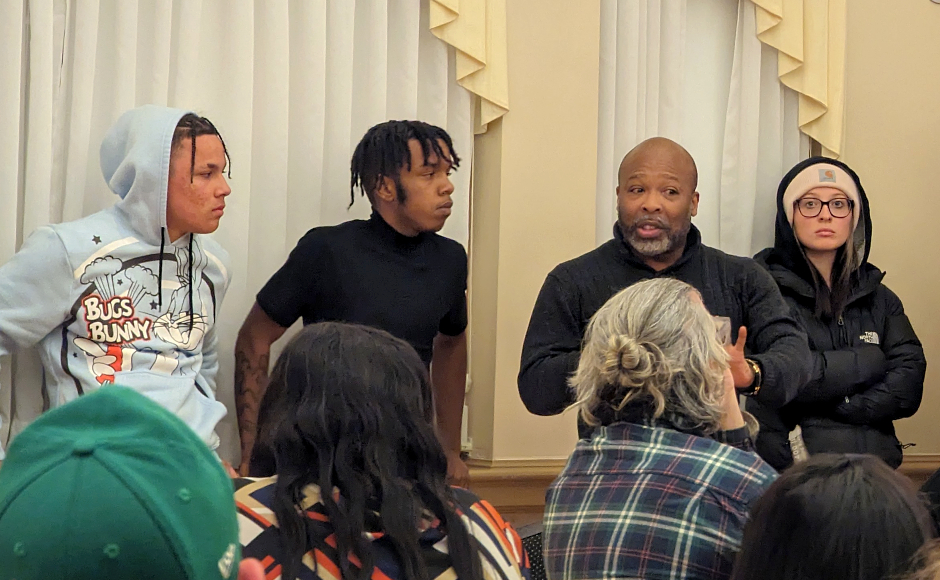
Charles Dowdy-Henderson (second from right) addresses a Collingswood community meeting about his daughter’s experiences in the school district. Credit: Matt Skoufalos.
A changing community
The superintendent did, however, offer that the borough of Collingswood itself “is in a state of growth and transition,” as its population “has dramatically shifted” since the turn of the century; the needs of the district mirror those changes.
If they’re not explainable in the context of a post-COVID social dynamic, they are certainly accounted for in demographic data that illustrate a community getting wealthier and less white over time.
According to U.S. Census data, in 2000, Collingswood was a town of 14,326 residents, 12,387 of which (86 percent) were white, 955 were Black (about 7 percent), and 347 (2.4 percent) were multiracial. The median household income was $43,175.
Ten years after that, the local population had fallen to 13,926 residents, of which 11,389 (82 percent) were white, 1,269 were Black (9 percent), and 356 (2.6 percent) were multiracial. The median household income had risen to $58,769.
By 2020, Collingswood had become a town of 14,186 residents, of which 11,349 (80 percent) were white, 1,787 were Black (13 percent), and 695 (4.9 percent) were multiracial. The median household income had risen to $78,809.
To regard conversations about the school climate at CHS as evidence of a recent or novel problem would mean ignoring the feedback from student walk-outs last year, in which residents and their children described personal experiences of racial bias in their interactions with the district.
There’s also its record of disproportionate discipline. A ProPublica data snapshot of CHS in 2015-16 found that, although the school population was 51 percent white, Black students were more than five times as likely as their white peers to be suspended from schools. White students in the district were more than three times as likely as their Black classmates to be in enrolled in an AP course.
Even before the student walk-outs, Collingswood has faced down significant community issues around race that played out within the borough school district.
In 2015, Collingswood Schools paid out $250,000 to settle a 2013 lawsuit from former CHS coach Joe McLaughlin, who claimed he was dismissed because he refused orders from his supervisors to put more white players on the school basketball team, as reported by Patch.com.
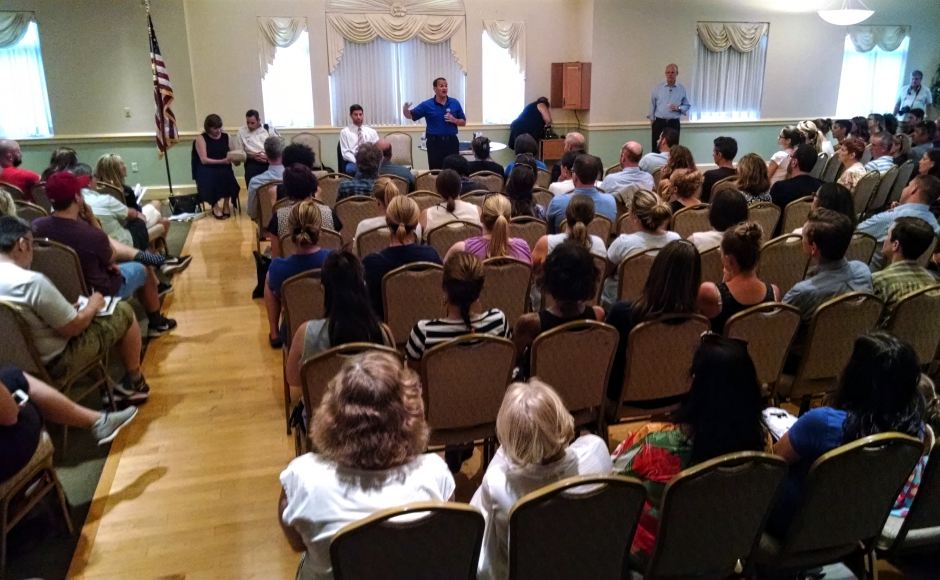
Collingswood residents attend a forum on police involvement in school discipline in 2016. Credit: Matt Skoufalos.
McLaughlin’s suit alleged that one athletic director told him that “white kids… needed representation on the team,” and that another objected to his recruitment of Black students from Camden City, saying that one “was not ‘a good fit’ for Collingswood High School.”
In 2016, Collingswood was roiled by the confused handling of the statewide memorandum of agreement that exists between law enforcement and school districts, which resulted in police being summoned to unpack even the most trifling disciplinary matters throughout the district.
The alleged inciting incident — an account that was later determined to have been unfounded — was rooted in a student interaction that was interpreted by staff as being racially charged.
The capstone to these experiences, however, came in February 2023, when Collingswood hosted a community reconciliation event to address the student reports of bias within the district. In that meeting, which followed the student-led walk-outs, district parents testified that, for years, their Black and brown children had been subject to racial profiling, interrogated by authorities without their parents’ awareness, or simply were told that “college was not in the cards” for them.
In response, McDowell said, the district is still working to manage the changes that underpin these concerns, starting with employee education.
“Staff asked us for supports around restorative justice and de-escalation; we’ve brought in outside consultants,” he said. “How do we build that knowledge base? Reading, learning from experts, working with facilitators. Right now, we’re in a state of learning.”
When working to repair divides in race and class, “there’s always a tension between what it looks like, and what people think it looks like,” McDowell said.
“We’re not trying to shove equity down the throats of people,” he said. “What we’re trying to say is, ‘Can we agree that all children matter in this community?’ and ‘Do our policies and procedures reflect the needs of all students in this community?’ We are working collaboratively with whoever is willing to work with us to address these challenges as they come.”
As for remarks that the current conditions in the district are “not Collingswood,” McDowell responded, “We are all Collingswood.
“Collingswood is diverse, rich in culture and history, and has demonstrated a capability for change,” he said. “Change is hard because there is always a perception of loss. Fearmongering and tearing things apart are not going to encourage people to stay. There are a large number of people doing good work.”
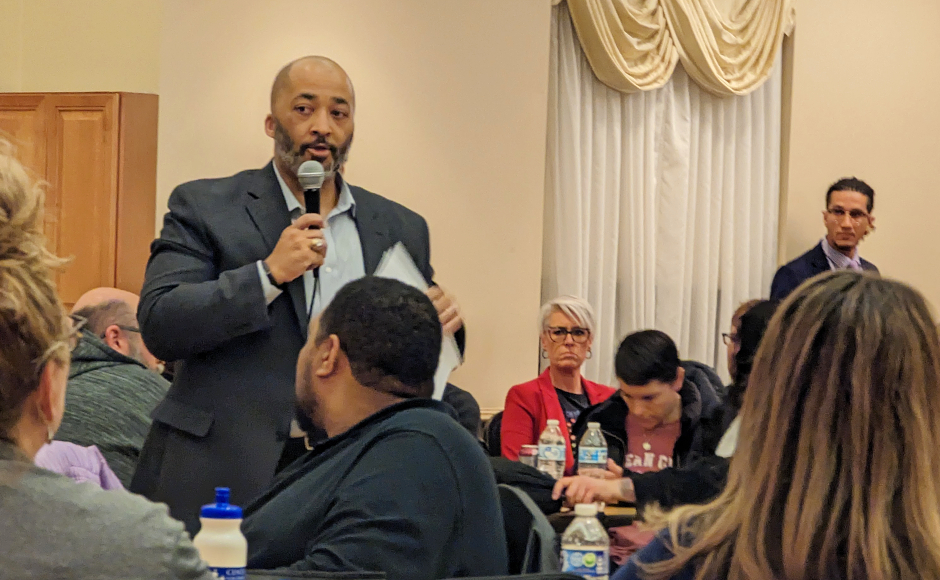
Collingswood Superintendent Fredrick McDowell addresses a community meeting about conditions in the district in 2023. Credit: Matt Skoufalos.
Nexus point
McDowell himself has become the focus of ire from some in the borough community, including residents, staff, and even last year’s student liaisons to the school board.
The renewal of his contract was a central campaign issue for a slate of challengers who did not win election to the Collingswood Board of Education last year.
Many remarks at the January 22 meeting were critical of the superintendent’s leadership, and his contract extension was not unanimously approved by the BOE.
However, the district is currently investigating what McDowell described as “a violation of ethical norms and confidentiality” around the process — namely, that the terms of his contract extension were leaked ahead of the vote. They emerged in discussions on social media in the hours before the meeting amid remarks about showing up to protest McDowell’s reappointment.
The obligation to keep the details of employee contracts in confidence is shared by both district professionals in the board office as well as members of the board themselves. So far, no information has emerged about how McDowell’s contract details got out ahead of the meeting.
“That information was not public, and is not willingly public,” the superintendent said.
“I’m here because I’m committed to the needs of our community,” he said. “Not everyone is going to be okay with how we do that work, or who is leading that work; I’m open to anyone who’s willing to [do the] work.
“There has to be a level of grace that we all extend to each other to not be so toxic and polarizing to each other,” McDowell said. “We all want to support our school community.”
Beyond extending the superintendent, Collingswood Schools still have a number of significant agenda items on the docket for the current calendar year.
Foremost among them is a new teacher contract, which is due by the end of June. Collingswood Education Association leadership did not respond to requests for comment for this article.
The district also is poised to deliver a school bond referendum to voters, the scope of which is not yet known, possibly as early as September. As superintendent of schools, McDowell will be tasked with shepherding it through the process.
Collingswood Board of Education President Regan Kaiden said the board is working to manage all the issues that are at the forefront of the district — staff retention, teacher contracts, school climate, and a potential referendum — alongside McDowell.
To make any improvements will require finding community buy-in.
“We want to figure out how to create the best environment for the students in Collingswood schools,” Kaiden said.
“I think it’s important for all of us to put the other stuff aside, and think of that as our North Star, because at the end of the day, that’s what a school system is all about.
“There’s a lot of important things to get done, and we need all voices at the table to solve those problems,” she said. “I don’t know how we got here, but I’m hoping we can find our way out.”
Kaiden attributed staff turnover issues not only to the post-COVID education landscape, but also to the unanticipated departure of McDowell’s predecessor, Scott Oswald, who served as superintendent for 14 years.
“There’s going to be a natural amount of turnover when a new person comes on for the first time,” she said. “That happens in many organizations. I think the fact that it happened in the middle of a global pandemic makes it different for our staff than it would have been if those things had not happened at the same time.
“Staff retention is something that we’ve talked with Dr. McDowell about a lot,” Kaiden said. “I’m interested in the retention numbers of new folks who are coming in. I think that’s an important indicator of how things are. It’s not like everyone that’s been hired in the last couple of years has also left.”
Matt Craig, who was re-elected to the Collingswood BOE in 2023, said that in addition to teacher retention and school climate issues, the board has concerns about aging facilities in the district, wants to improve its academic rigor, and evaluate whether the current alignment of the district lets teachers easily coordinate planning among their cohorts within grade levels.
“Diversity, culture, increasing rigor — these are all things we want to see happen, but they’re challenging,” Craig said. “These are things that all kinds of districts would like to see improvements in.
“We are ahead of the curve on the mental health grants, and physical space in the secondary building, and we’ve done a lot of investments there to help kids beyond academics,” he said.
“I want to continue to have conversations, and work with folks,” Craig said. “I feel like a lot has happened, but a lot still needs to.”

